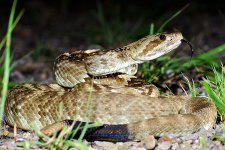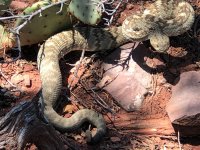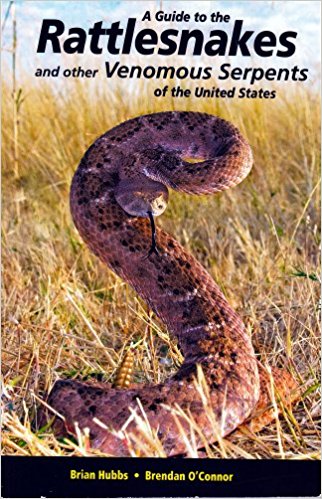| Range: |
 |
| Other Names: |
Black-tailed Rattlesnake, Green Rattler, Ornate Blacktail |
| Description: |
A large 22"- 48" rattlesnake that may be brown, gray, yellow-brown,
or straw colored with a series of large, black or brown, blotches on
the back. The blotches are jagged-edged. A few light patches mark the
interior of each dorsal blotch. The blotches are eight sided with thin
lined running down the sides to the belly. On the posterior part of
the body the blotches become narrow, muted crossbands. The pupils are
vertical and the dorsal scales are keeled. The neck is slender and
the head is wide and triangular. The body color gradually fades in to
a solid black tail. |
| Similar Species: |
The easiest way to tell the two species of Blacktails in New Mexico apart is the connection of the anterior blotches dorsolaterally in the Eastern Blacktail. The anterior blotches in the Northern Blacktail tend to remain separate along the sides. The solid-colored black or dark brown tail and the light scales within the dark body blotches should distinguish this from other rattlesnakes in New Mexico. |
| Venom: |
Venomous |
| Habitat: |
This snake is found at low regions up to 8,000'. It is found in a wide
variety of Desertscrub to lower Conifer Forest. It seems to be most
abundant in the woodlands. It is almost always found above the flats
in hilly or mountainous terrain. |
| Behavior: |
Is diurnal but can be crepuscular in spring and fall and becomes
nocturnal during the hot summer months. Usually a calm snake. |
| Hibernation: |
Hibernates in deep cracks. Known to communal den with Western Diamondbacks (C. atrox) and Rock Rattlesnakes (C. lepidis) |
| Reproduction: |
Gives live birth. |
| Diet: |
It feeds on mice, rats, rabbits, other small mammals, birds, and lizards. |
Authored by: Garth Teitjen


















